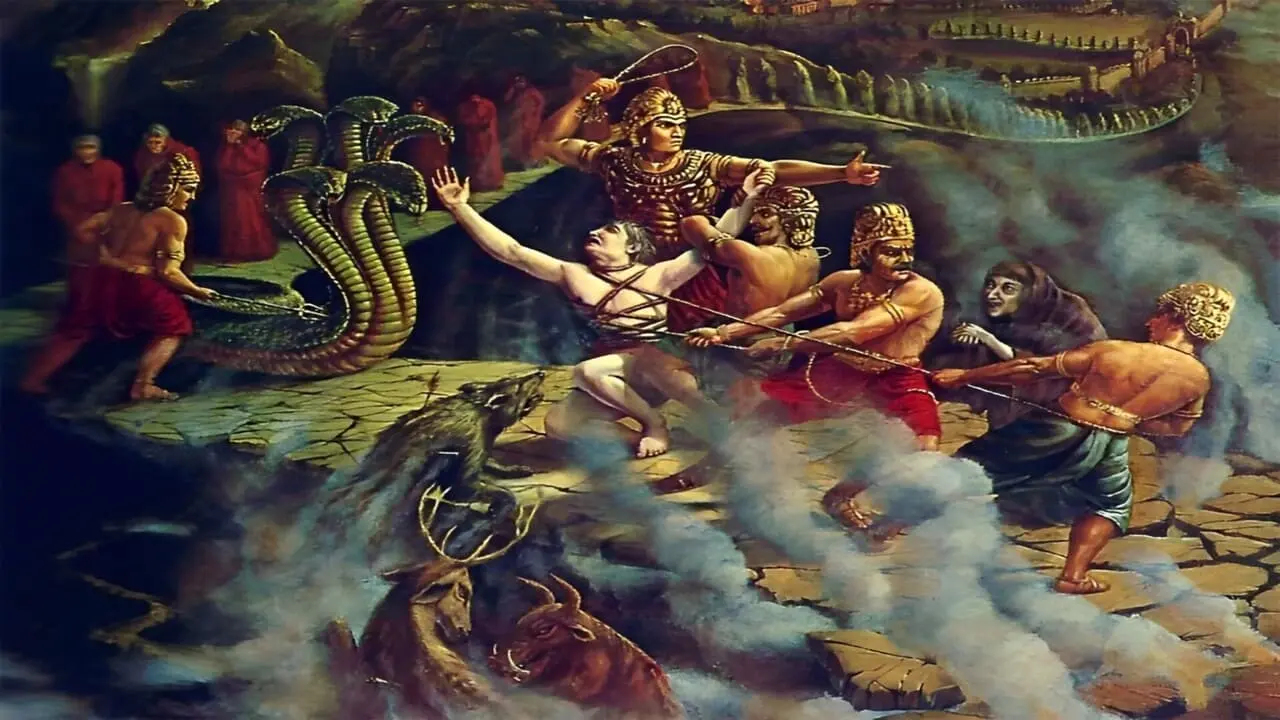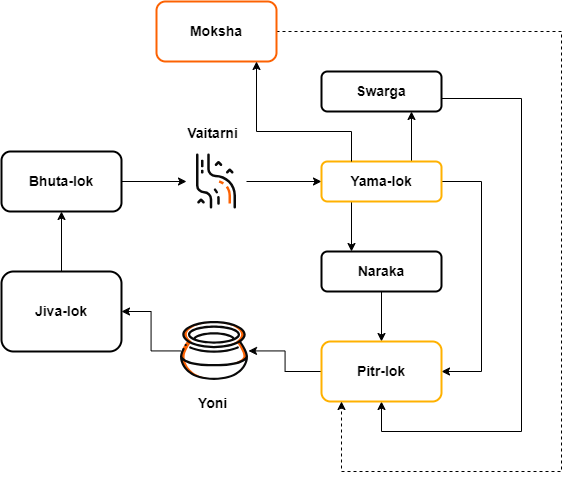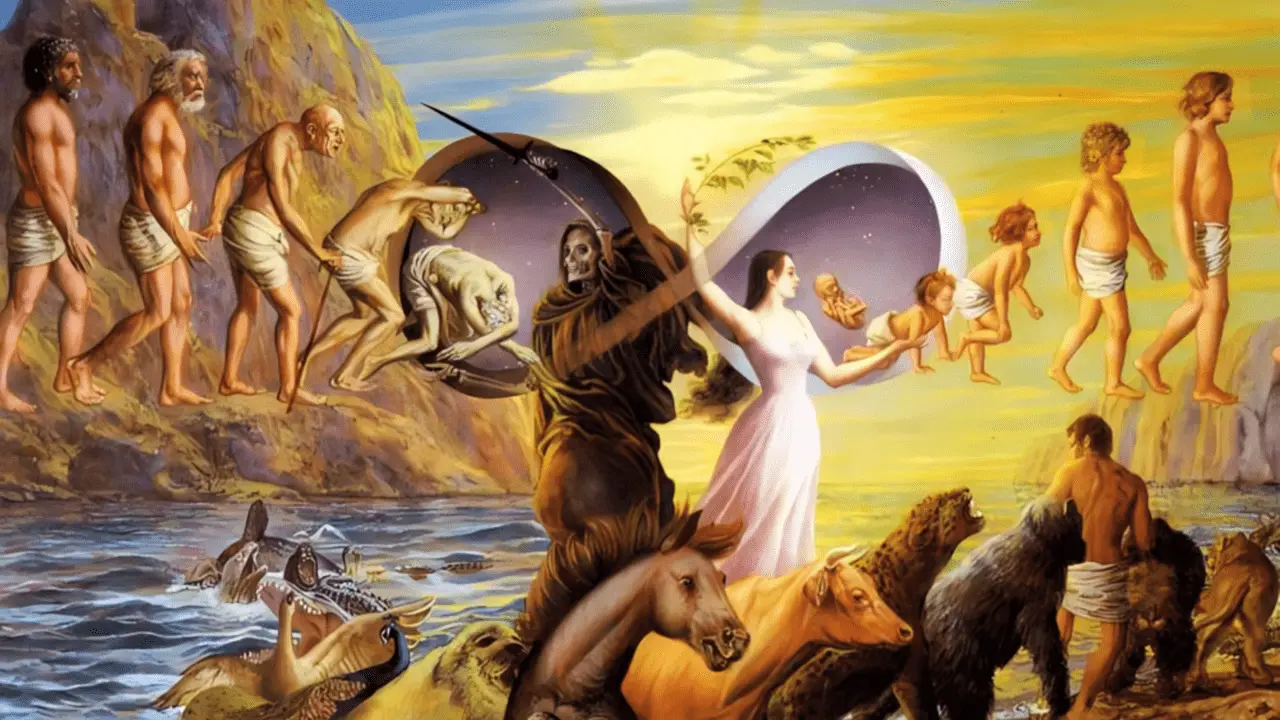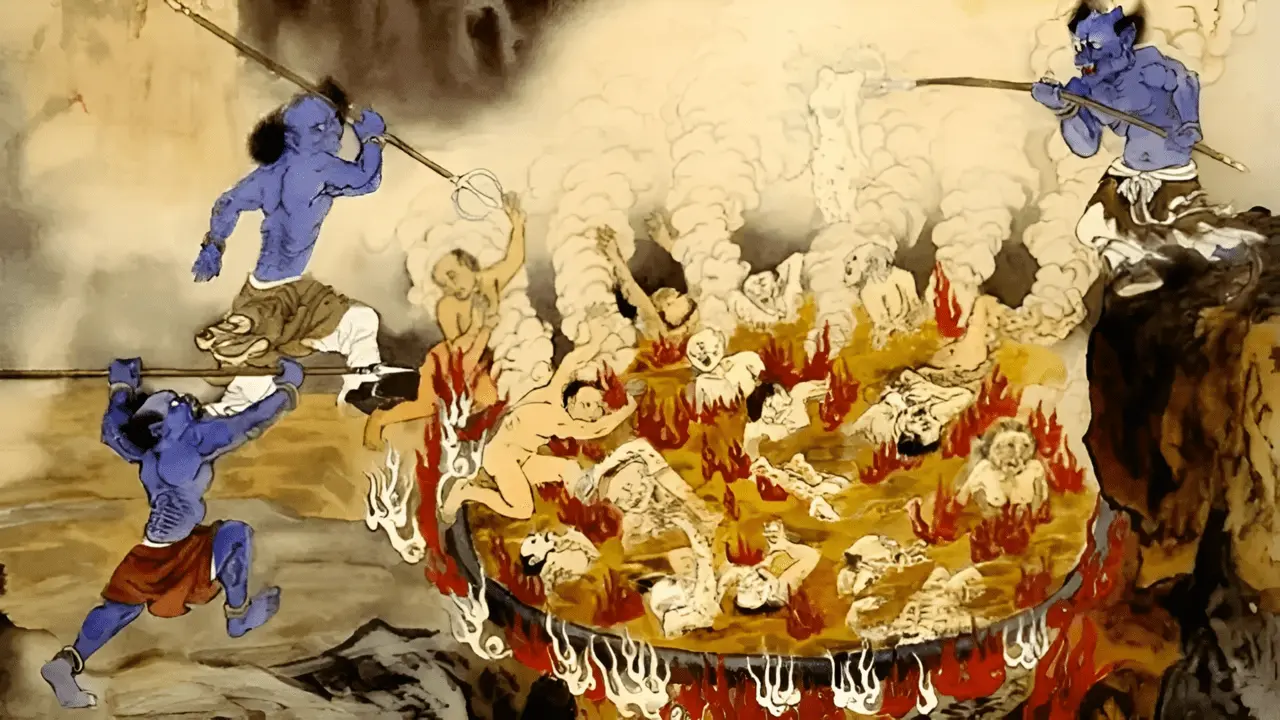
Journey Of The Soul After Death : Towards Moksha
Hindu beliefs provide a profound understanding of life, death, and the journey of the soul. According to ancient scriptures like the Garuda Purana, the journey of the soul after death is divided into four phases and leads to one of four possible destinations. This journey is intricately tied to one’s karma, dharma (righteousness), and the way they lived their life. Here’s a simplified exploration of this journey.

4 Phases of Journey of the Soul
1. Leaving The Body
2. Wandering Near the Body
3. The Year-long Journey
4. Yama-lok
Phase 1 : Leaving the Body
As a person approaches death, they often struggle to stay alive, even if they are old, sick, or weak. When the time comes, Yama’s messengers, called the Yama-duta, appear. These figures are frightening, ugly and naked with red eyes and sharp nails, and they come to take the soul, known as the preta, out of the body. This process is painful, like being stung by many scorpions. The preta, which is small and about the size of a thumb, looks back at the body it has left behind as it is taken away.
The soul leaves the body more easily when the body is cremated (mukha-agni). During the cremation, special Vedic hymns (antyeshti) are recited to help the soul leave peacefully. The final act of breaking the skull at the top of the head allows the soul to exit smoothly.
The soul leaves the body more easily when the body is cremated (mukha-agni). During the cremation, special Vedic hymns (antyeshti) are recited to help the soul leave peacefully. The final act of breaking the skull at the top of the head allows the soul to exit smoothly.
Phase 2 : Wandering Near the Body
After leaving the body, the preta stays near the corpse, confused and not wanting to leave. It lingers in the crematorium, watching over its former body until the Yama-duta come to take it away. The soul is dragged towards Yama’s abode, and if it resists, it is beaten and forced to move. This journey is difficult, with the soul feeling intense thirst, hunger, and heat.
A lamp is lit at the time of death to give the preta hope that it is not forgotten. The preta is given a temporary body through the nava-shradh rituals, which allow it to eat the offerings made by loved ones during the year-long journey to Yama-lok.
The preta suffers because of its memories and desires. In contrast, those who let go of memories and desires do not feel this pain. Souls that escape the Yama-duta become stuck in the crematorium, turning into ghosts (bhuta), and over time, some may become pishachas—spirits that trouble the newly deceased.
A lamp is lit at the time of death to give the preta hope that it is not forgotten. The preta is given a temporary body through the nava-shradh rituals, which allow it to eat the offerings made by loved ones during the year-long journey to Yama-lok.
The preta suffers because of its memories and desires. In contrast, those who let go of memories and desires do not feel this pain. Souls that escape the Yama-duta become stuck in the crematorium, turning into ghosts (bhuta), and over time, some may become pishachas—spirits that trouble the newly deceased.
Phase 3 : The Year-long Journey
After leaving the body, the soul begins a difficult journey. The path to the land of the dead is harsh, with no shade, burning heat, cold winds, and dangerous animals. The road is filled with thorns, fire, and frightening creatures like tigers, dogs, and snakes. Yama’s messengers, the Yama-duta, drag and beat the soul, forcing it to keep moving. This suffering happens because the person didn’t follow dharma during their life.
During the journey, the soul passes through many places that remind it of missed opportunities and regrets. It feels sad for not living a good life. However, the soul can rest and eat the offerings made by its family members. These offerings give the soul strength for the journey.
Around six months after death, the soul reaches the Vaitarni River, a terrible river filled with bones, blood, and pus. Those who did good deeds in life, like giving a cow, can cross the river in a boat. Others are dragged through the river by hooks. After a year, the soul finally reaches Yama’s city. Here, a ritual called sapinda-karana is performed, turning the soul into an ancestor (pitr). This ritual completes the soul’s journey, and the soul takes its place among the ancestors.
During the journey, the soul passes through many places that remind it of missed opportunities and regrets. It feels sad for not living a good life. However, the soul can rest and eat the offerings made by its family members. These offerings give the soul strength for the journey.
Around six months after death, the soul reaches the Vaitarni River, a terrible river filled with bones, blood, and pus. Those who did good deeds in life, like giving a cow, can cross the river in a boat. Others are dragged through the river by hooks. After a year, the soul finally reaches Yama’s city. Here, a ritual called sapinda-karana is performed, turning the soul into an ancestor (pitr). This ritual completes the soul’s journey, and the soul takes its place among the ancestors.
Phase 4 : Yama-lok
Yama Lok is the land of Yama, the god of death, located in the southern direction. Yama rules this place, sitting on a grand throne. He appears kind to those who lived good lives but becomes terrifying to those who did not follow dharma.
Chitragupta, Yama’s scribe, records the deeds of every soul. The soul’s journey in Yama Lok depends on its actions during life. There are four roads to Yama’s house, each one taken by souls based on what they did in life. The generous take the eastern path, the brave take the northern path, those who lived with restraint take the western path, and those who lived selfishly are dragged down the southern path.
In Yama Lok, the soul is judged and either rewarded or punished based on its past actions. After this judgment, souls may spend time in Swarg (heaven) or Naraka (hell) before being reborn. Some may return as humans, while others, depending on their karma, might come back as animals or insects. Yama advises everyone to live with kindness and self-control to break free from the cycle of rebirth.
The shradh rituals, performed by the living, help the soul complete its journey and become an ancestor. These rituals also mark the end of the soul’s journey to Yama Lok and prepare it for the next phase in the cycle of life and death.
Chitragupta, Yama’s scribe, records the deeds of every soul. The soul’s journey in Yama Lok depends on its actions during life. There are four roads to Yama’s house, each one taken by souls based on what they did in life. The generous take the eastern path, the brave take the northern path, those who lived with restraint take the western path, and those who lived selfishly are dragged down the southern path.
In Yama Lok, the soul is judged and either rewarded or punished based on its past actions. After this judgment, souls may spend time in Swarg (heaven) or Naraka (hell) before being reborn. Some may return as humans, while others, depending on their karma, might come back as animals or insects. Yama advises everyone to live with kindness and self-control to break free from the cycle of rebirth.
The shradh rituals, performed by the living, help the soul complete its journey and become an ancestor. These rituals also mark the end of the soul’s journey to Yama Lok and prepare it for the next phase in the cycle of life and death.
4 Destinations of the Soul
1. Naraka (Hell)
2. Swarga (Heaven)
3. Moksha (Higher Heaven)
4. Pitr-lok (Ancestral Realm)
Destination 1 : Naraka (Hell)
Before a soul is reborn, it must endure the consequences of its past actions in various hells, as described in the Garuda Purana. Each hell is specifically designed to punish a particular sin committed in the previous life. The punishments are severe, involving fire, weapons, acid, wild animals, and venomous snakes. Souls may be beaten, crushed, thrown into pits of sewage, or submerged in rivers of pus. These tortures aim to teach lessons about respecting one’s own body, fulfilling duties, and not violating the trust or property of others.
The ancient texts, including the Mahabharata, Ramayana, Agni Purana, and Garuda Purana, express strong condemnation for those who engage in corrupt practices, cruelty, pride, stinginess, or sexual misconduct. The intense suffering in Naraka serves as a warning to avoid such behaviors and to live a life aligned with dharma.
The ancient texts, including the Mahabharata, Ramayana, Agni Purana, and Garuda Purana, express strong condemnation for those who engage in corrupt practices, cruelty, pride, stinginess, or sexual misconduct. The intense suffering in Naraka serves as a warning to avoid such behaviors and to live a life aligned with dharma.
Destination 2 : Swarga (Heaven)
While hell is emphasized more in the Garuda Purana, the concept of heaven, or Swarga, also exists. Swarga is a place of eternal pleasure and luxury, where good souls are rewarded for their virtuous deeds. In Swarga, souls are treated to the finest foods, the divine drink Soma, and the entertainment of celestial dancers (apsaras), singers (Kinnaras), and musicians (Gandharvas). This paradise is filled with wish-fulfilling treasures like the Kalpa-taru (wish-fulfilling tree), Kama-dhenu (wish-fulfilling cow), Chinta-mani (wish-fulfilling jewel), and the Akshaya-patra (vessel of endless abundance). There is no decay, disease, or death in this heavenly realm.
Those who performed good deeds, such as giving gifts, being kind and fair, helping others, and fulfilling their duties, are welcomed into Swarga. However, their stay in this blissful place is not permanent. Once their merits are exhausted, they must leave. Stories from the Mahabharata, like those of King Yayati and Indradyumna, illustrate this temporary nature of Swarga. To achieve permanent bliss, souls must strive for the higher heavens beyond Swarga.
Those who performed good deeds, such as giving gifts, being kind and fair, helping others, and fulfilling their duties, are welcomed into Swarga. However, their stay in this blissful place is not permanent. Once their merits are exhausted, they must leave. Stories from the Mahabharata, like those of King Yayati and Indradyumna, illustrate this temporary nature of Swarga. To achieve permanent bliss, souls must strive for the higher heavens beyond Swarga.
Destination 3 : Moksha (Higher Heaven)
The two main higher heavens are Kailasa, the abode of Shiva, and Vaikuntha, the abode of Vishnu. Kailasa is a place of peace where no one goes hungry—Shiva’s bull does not eat grass, and Shakti’s tiger does not hunt. In Vaikuntha, which is located in an ocean of milk (symbolizing abundance), there is no conflict, unlike in Indra’s Swarga, which is often under attack.
Other heavens include Brahma-loka for sages, Gauri-loka for women who were faithful to their husbands, and Saket, the heaven of Sita and Ram, where everyone enjoys the rule of dharma (Ram-rajya). In Go-loka, Krishna’s heaven, cows freely give milk, filling the ocean of milk. There are also special heavens for the devotees of Ganesha and Hanuman. In these higher heavens, there is no return to the world of suffering; only eternal bliss remains.
However, if any resident shows signs of ego, jealousy, hatred, or other negative emotions, they are cast out and must be reborn until they are ready to return to the higher heavens. This is similar to the story of the Yoginis who were cursed and cast out of Kailasa.
Other heavens include Brahma-loka for sages, Gauri-loka for women who were faithful to their husbands, and Saket, the heaven of Sita and Ram, where everyone enjoys the rule of dharma (Ram-rajya). In Go-loka, Krishna’s heaven, cows freely give milk, filling the ocean of milk. There are also special heavens for the devotees of Ganesha and Hanuman. In these higher heavens, there is no return to the world of suffering; only eternal bliss remains.
However, if any resident shows signs of ego, jealousy, hatred, or other negative emotions, they are cast out and must be reborn until they are ready to return to the higher heavens. This is similar to the story of the Yoginis who were cursed and cast out of Kailasa.
Destination 4 : Pitr-lok
The ancestors reside in Pitr-loka, where they patiently wait for their rebirth. They accept offerings made during shradh ceremonies. According to the Mahabharata, but not the Garuda Purana, these ancestors are said to hang upside down over a bottomless pit called Put, hoping that their descendants will produce children who will save them from this condition.
Conclusion
The journey of the soul after death is a central theme in Hindu beliefs, emphasizing the importance of living a righteous life in accordance with dharma. The phases of this journey highlight the consequences of one’s actions and the importance of karma in determining the soul’s final destination.
This journey is not just about punishment or reward but serves as a reminder of the transient nature of life and the importance of spiritual growth. Ultimately, the goal is to break free from the cycle of rebirth and attain moksha, the ultimate liberation where the soul merges with the divine and experiences eternal peace.
This journey is not just about punishment or reward but serves as a reminder of the transient nature of life and the importance of spiritual growth. Ultimately, the goal is to break free from the cycle of rebirth and attain moksha, the ultimate liberation where the soul merges with the divine and experiences eternal peace.




